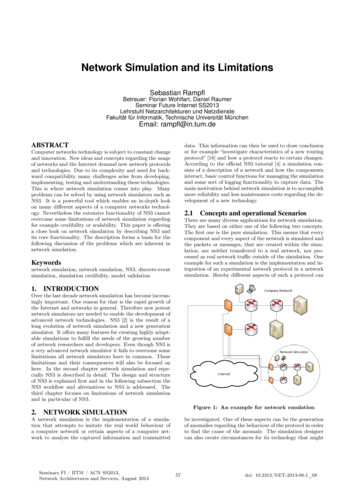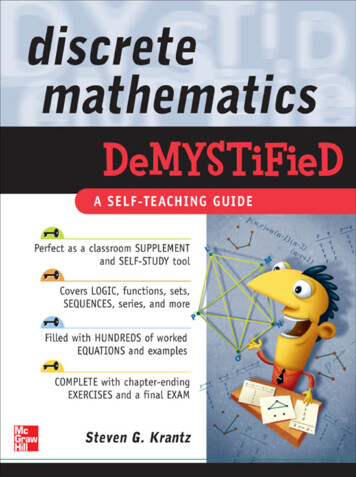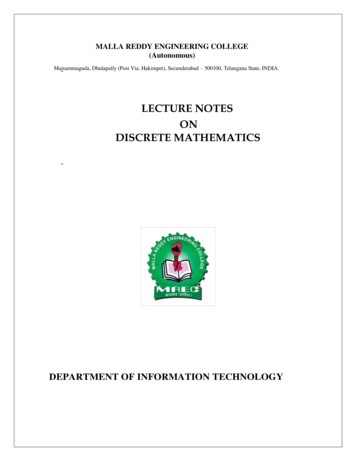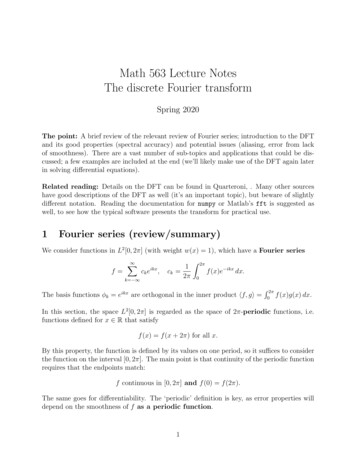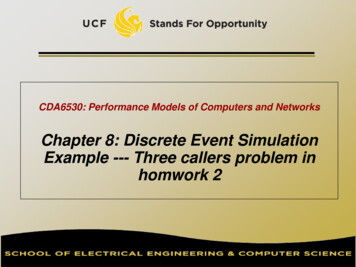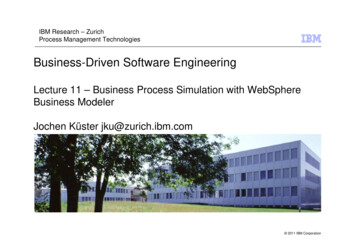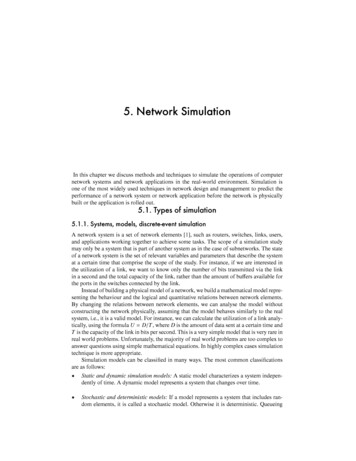
Transcription
Introduction to Discrete-EventSimulationReference book: "Simulation, Modeling & Analysis (3/e) by Law and Kelton, 2000"OutlineSystem, Model, and Simulation System: Discrete and ContinuousWays to Study a SystemWhy ModelModel TaxonomyWhy SimulationDiscrete-Event Simulation What is Discrete-Event Simulation (DES)Example: A Single Server SystemAdvancement of Simulation TimeComponents and Organization of Discrete-Event Simulation ModelDesign of Event ListExample: A Single Server System Sample Design for Event-Scheduling Sample Design for Arrival and Departure EThe Stages of a Simulation Project
System: Discrete and Continuous System:- a collection of entities that act and interact together towardthe accomplishment of some logical end. Discrete system:- state variables change instantaneously at separated point intime, e.g., a bank, since state variables - number ofcustomers, change only when a customer arrives or when acustomer finishes being served and departs Continuous system:- state variable change continuously with respect to time, e.g.,airplane moving through the air, since state variables position and velocity change continuously with respect totimeWays To Study a SystemSystemExperimentwith actualsystem- A At-v \ , 1 WL Experimentwith a model ofactual system
Why Model?Model:- A representation of the system and study it as a surrogate forthe actual systemWhy Model?- System is not physically exists- Building a system is expensive- Measuring a system is time-consumingCharacterizing a Model- Deterministic or Stochastic Does the model contain stochastic components?- Static or Dynamic Is time a significant variable?- Continuous or Discrete Does the system state evolve continuously or only at discretepoints in time? Continuous: classical mechanics Discrete: queuing, inventory, machine shop modelsModel Taxonomy/\Monte Carlo simulation/continuous discretecontinuous discretediscrete-event simulation
Why Simulation?Many systems are highly complex, precluding thepossibility of analytical solutionThe analytical solutions are extraordinarily complex,requiring vast computing resourcesThus, such systems should be studied by means ofsimulation- numerically exercising the model for inputs in question tosee how they affect the output measures of performance"Simulation is the process of designing a model of a real system andconducting experiments with this model for the purpose either ofunderstanding the behavior of the system or of evaluating variousstrategies (within the limits imposed by a criterion or set of criteria) forthe operation of a system."-Robert E Shannon 1975What is Discrete-Event Simulation (DES)A discrete-event simulation- models a system whose state may change only at discrete pointin time.System- is composed of objects called entities that have certainproperties called attributesState- a collection of attributes or state variables that represent theentities of the system.Event- an instantaneous occurrence in time that may alter the state ofthe systemAn event initiates an activity, which is the length of timeduring which entities engage in some operationsEntities, attributes, events, activities and theinterrelationships between these components are definedin the model of the system
Example: A Single Server System Entities: customers; server Attributes of a customer: service required Attributes of server: server's skill (its service rate) Events: arrival of a customer; departure of acustomer Activities: serving a customer, waiting for a newcustomerQueue ServerCustomer Arrival-Customer DepartureWhat is Discrete-Event Simulation (DES)Discrete-event simulation is stochastic, dynamic, anddiscreteStochastic Probabilistic- Inter-arrival times and service times are random variables- Have cumulative distribution functionsDiscrete Instantaneous events are separated by intervalsof time- The state variables change instantaneously at separate points in time The system can change at only a countable number of points in time.- These points in time are the ones at which an event occurs.Dynamic Changes overtime- Simulation clock Keep track of the current value of simulated time as the simulation proceeds- A mechanism to advance simulated time from one value to another Next-event time advance
Advancement of Simulation Time Fundamental to every simulation study is amechanism to model the passage of time Every model contains a variable called the internalclock, or the simulation clock Time may be modeled in a variety of ways withinthe simulation How do we advance simulated time?- Time as linked events (Next-event time advance)- Time divided into equal increments (Fixed-increment timeadvance)Advancement of Simulation Time Time as linked events (Next-event time advance)- All state changes occur only at event times for a discreteevent simulation model- Periods of inactivity are skipped over by jumping the clockfrom event time to event time- This method is called event-driven DES and is asynchronousas opposed to time-stepped approach which is synchronous Time divided into equal increments (Fixedincrement time advance) stl st2 st3 st4 - Stw
Components and Organization of DiscreteEvent Simulation ModelInitialization Routinei. set simulation ciock 02. Initialize system stateand statistical counters3. Initialize event listMain Program0. Invoke the initialization routine1. Invoke the timing routine2. Invoke event routine i RepeatedlyEvent routine i X1. Update system state2. Update statistical counters3. Generate future events and add toevent list1. Determine the nextevent type, say, I2. Advance thesimulation clockLibrary routinesrandom4 * Generatevariables re simulations, s. over? Report generator X1. Compute estimates of Interest2. Write reportDefinitions are inthe next two slidesComponents and Organization of DiscreteEvent Simulation Model System state- The collection of state variables necessary to described thesystem at a particular time Simulation clock- A variable giving the current value of simulated time Event list- A list containing the next time when each type of event willoccur Statistical counters- Variables used for storing statistical information about systeminformation Initialization routine- A subprogram to initialize the simulation model at time 0 Timing routine- A subprogram that determines the next event from the event listand then advances the simulation clock to the time when thatevent is to occur
Components and Organization of DiscreteEvent Simulation Model Report generator- A subprogram that computes estimates (from the statistical counters) ofthe desired measures of performance and produces a report when thesimulation ends Event routine- A subprogram that updates the system state when a particular type ofevent occur There is one event routine for each event type Library routines- A set of subprogram used to generate random observations fromprobability distributions that were determined as part of the simulationmodel Main program- A subprogram that invokes the timing routine determine the next event and- transfer control to the corresponding event routine update the system state appropriately- check for termination invoke the report generator when the simulation is over.Design of Event ListEvents are chronologically ordered in time.Event List- sometimes called the pending event set because it listsevents that are pending.- contains all scheduled events, arranged in chronologicaltime order.- In the simulator, this is just a data structure, e.g. list, treeEt0 Et1 Et3 Etnf fl— -JCurrent Time for En generates a new event Et1,Time Next Event which is placed at the appropriateposition in the event list using timet f
Example: A Single Server System Entities: customers; server Attributes of a customer: service required Attributes of server: server's skill (its service rate) Events: arrival of a customer; departure of acustomer Activities: serving a customer, waiting for a newcustomerQueueCustomer Arrival-ServerCustomer DepartureSample Design for Event-SchedulingMain (executive routine):1. set clock 02. set cumulative statistics to 03. define initial system state (queue empty, server idle)4. generate the occurrence time of the first arrival and place in eventlist5. select the next event on event list (arrival or departure event)6. advance simulation clock to time of next event7. process this event (execute the corresponding event routine)8. if not end-of-simulation, goto step 5
Sample Design for Arrival and DepartureEvent RoutineArrivalEventSchedule the nextarrival eventYesYes /rathe serveN NoV. b u s y ? 1Subtract 1 fromthe number inqueueMake the serverIdle"'Schedule adeparture eventfor this customerMake the severbusyAdd 1 to thenumber In queue1Schedule adeparture eventfor this customerCollect statisticstCollect statisticsfReturnC Return )JThe Stages of a Simulation ProjectPlanning- Problem Formulation: what is it and what do I want to do withit?- Resource Estimation: time, people and money.- System and Data AnalysisModeling- Model Building: find relationships.- Data Acquisition: find and collect appropriate data.- Model Translation: program and debug.Verification and Validation- Verification: does the PROGRAM execute as intended?- Validation: does the PROGRAM represent reality asintended?Typically an iterative process
ConclusionIt is not so hard to write a simulation programEfficiency is critical point to a simulation programReferenceSimulation, Modeling & Analysis (3/e) by Law andKelton, 2000www.cs.wm.edu/ / giam/91.570/Lect1/Lecture1 07/project/Simulation.pdf
Simulation Reference book: "Simulation, Modeling & Analysis (3/e) by Law and Kelton, 2000" Outline System, Model, and Simulation . Discrete: queuing, inventory, machine shop models Model Taxonomy /\ Monte Carlo simulation / continuous discrete continuous discrete discrete-event simulation. Why Simulation?

